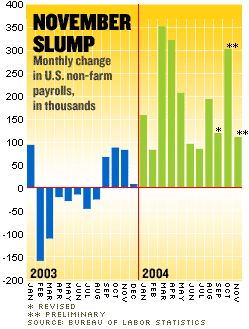NEW YORK (CNN/Money) -
Job growth slowed significantly in November, according to a government report Friday that came in far weaker than Wall Street forecasts and trimmed the strong number reported in the previous month.
| 
| |

| 
| 
|

|
 Labor Secretary Elaine Chao comments on the weak November jobs report. Labor Secretary Elaine Chao comments on the weak November jobs report.
|
 Play video
Play video
(Real or Windows Media)
|
| 
|

|
|
The report raised new concerns about the strength of the economy going into the important holiday buying season. It also suggested the much stronger-than-expected job gain posted in October was perhaps a blip and not the start of a labor market recovery.
The Labor Department's November report showed a seasonally-adjusted net gain of 112,000 jobs, down from a revised 303,000 the previous month. Economists surveyed by Briefing.com had forecast an increase of 200,000 jobs to non-farm payrolls in the November period.
The unemployment rate fell to an expected 5.4 percent from 5.5 percent in October. The unemployment rate is based on a survey of households, which is generally considered less reliable than the survey of employers that produces the payroll number.
The household survey found a big jump in the number of people at work -- 483,000 jobs, and a 45,000 decline in the number of unemployed.
One factor behind the weaker-than-expected job growth is a loss of 16,000 jobs in the retail sector. The Labor Department makes a seasonal adjustment to account for the pre-holiday hiring by retailers and some economists warned that the weaker-than-expected number could be caused at least partly by that adjustment.
"I think clearly the retail employment number is goofy," said John Silvia, chief economist with Wachovia Securities. "I think when that number is revised and we look back several months, we'll eventually see a gain."
Silvia also questioned whether the business and professionals service sector reading, which showed a gain of 28,000 jobs, was also missing some of the gains in the sector.
Other economists said the retail employment drop is a sign that the major retailers are being cautious heading into the holiday period.
"I think a seasonal factor is part of the issue here, but you can't discount it all," said Anthony Chan, senior economist with J.P. Morgan Fleming Asset Management. "Look at what is happening with chain store sales. They've been pretty weak. Some of it (weak retail employment) is real."
Trouble ahead?
The manufacturing sector also lost 5,000 jobs according to the report, and the government revised lower the overall gains originally reported in both September and October.

October had originally been posted as a 337,000 job gain, well above forecasts at the time, while September was revised to a 119,000 job gain, down from earlier reading of 139,000.
Even with the strong October number, job growth over the last six months has now averaged only 152,000 new jobs a month, or just what is needed to keep up with population and labor force growth.
Silvia said seasonal adjustments and other technical factors explain only part of the weakness in the report. He said the broad look at weak employment in the three years of this economic recovery suggests some structural changes in the U.S. labor market.
"In our society we've got to come to grips with employment gains of less than we were used to in the 1990s," he said.
Wachovia has been looking for gains of just over 200,000 a month through 2005. Some economists say this report shows those kinds of projections are too optimistic.
"After a brief reprieve, the specter of a winter jobs drought looms large and frightening," said University of Maryland professor Peter Morici.
The report also showed a slight decline in the average work week in the private sector, down to 33.7 hours from 33.8 in October, while average hourly wages crept up only 1 cent to $15.83, the narrowest increase posted so far this year.
Bond prices soared and yields on the 10-year treasury, which moves in the opposite direction, fell to 4.24 percent at midday from about 4.40 percent before the report. Traders saw this weakness as perhaps slowing the Federal Reserve's plans for measured interest rate hikes or lessening the chance that the Fed might need to increase rates more rapidly.
"Going into this report, many analysts greatest fear was that the Fed may have lost some control of this budding recovery," said Chan. "The actual evidence shows that a moderate recovery is exactly what we are likely to get."
Most economists still expect another quarter-percentage point rate hike at the Dec. 14 meeting.
U.S. stock markets were slightly higher in midday trading, although it was led higher by tech stocks that were seen as being helped by the bullish sales outlook late Thursday from Intel Corp. (Research) The Dow Jones industrial average and Standard & Poor's 500 both trailed the tech-heavy Nasdaq.

|


